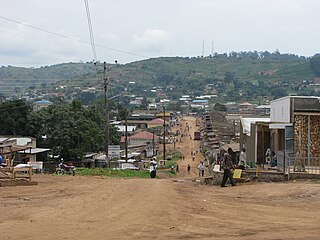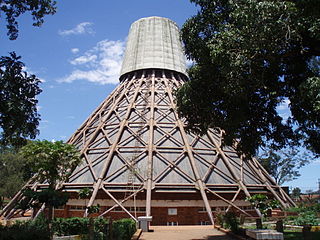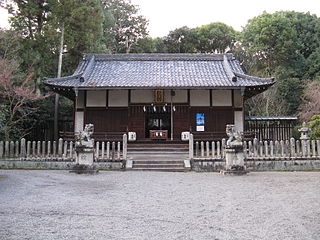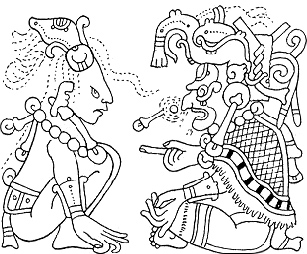
Prayer is an invocation or act that seeks to activate a rapport with an object of worship through deliberate communication. In the narrow sense, the term refers to an act of supplication or intercession directed towards a deity or a deified ancestor. More generally, prayer can also have the purpose of thanksgiving or praise, and in comparative religion is closely associated with more abstract forms of meditation and with charms or spells.

Odinani, also known as Odinala, Omenala, Odinana, and Omenana, is the traditional cultural belief and practice of the Igbo people of south east Nigeria. These terms, as used here in the Igbo language, are synonymous with the traditional Igbo "religious system" which was not considered separate from the social norms of ancient or traditional Igbo societies. Theocratic in nature, spirituality played a huge role in their everyday lives. Although it has largely been syncretised with Catholicism, the indigenous belief system remains in strong effect among the rural, village and diaspora populations of the Igbo. Odinani can be found in Haitian Voodoo, Obeah, Santeria and even Candomblé. Odinani is a pantheistic and polytheistic faith, having a strong central deity at its head. All things spring from this deity. Although a pantheon of other gods and spirits, these being Ala, Amadiọha, Anyanwụ, Ekwensu, Ikenga, exists in the belief system, as it does in many other Traditional African religions, the lesser deities prevalent in Odinani serve as helpers or elements of Chukwu, the central deity.

Inari Ōkami, also called Ō-Inari (大稲荷), is the Japanese kami of foxes, fertility, rice, tea, sake, agriculture and industry, and general prosperity and worldly success, and is one of the principal kami of Shinto. The name Inari can be literally translated into "rice-bearer". In earlier Japan, Inari was also the patron of swordsmiths and merchants. Alternatingly-represented as male and/or female, Inari is sometimes seen as a collective of three or five individual kami. Inari appears to have been worshipped since the founding of a shrine at Inari Mountain in 711 CE, although some scholars believe that worship started in the late 5th century.

The St Thomas Syro Malabar Catholic International Shrine, Malayattoor is one of the eleven international shrines in the world, situated in Malayattoor Angamaly, Ernakulam district of Kerala, India.
Ssuuna II Kalema Kasinjo Mukaabya Sekkyungwa Muteesa Sewankambo Walugembe Mig'ekyaamye Lukeberwa Kyetutumula Magulunyondo Luwambya Omutanda Sseggwanga was Kabaka of the Kingdom of Buganda from 1832 until 1856. He was the twenty-ninth Kabaka of Buganda.

Na Tuk Gong are local guardian spirits worshipped by overseas Chinese communities in Malaysia, Singapore and parts of Indonesia, especially Sumatra. An alternate more generic name for the cult is Datuk Gong, uniting Dato or Datuk from the local Malay word for 'grandfather', which is also used as an honorific title, and Kong or Gong from Chinese, also an honorific title. According to Taoist tradition, a Na Tuk Kong's could hold the official title 拿督尊王. Datuk Keramat, Datuk Gong and Na Tuk Kong all refer to the same deity. For the sake of clarity, the term Datuk, which is universally used to describe the spirit in Malaysia, will be used.

Mubende is a town in the Central Region of Uganda. It is the main municipal, administrative, and commercial center of Mubende District and the location of the district headquarters.

Akkorokamui is a gigantic octopus-like monster from Ainu folklore, similar to the Nordic Kraken, which supposedly lurks in Uchiura Bay in Hokkaido. It is said that its enormous body can reach sizes of up to 120 metres in length. Its name can be translated as "tentacle-holding kamuy."
Articles related to Uganda include:

The Vilwadrinatha Temple is a Hindu temple in Thiruvilwamala, a town in the city of Thrissur, Kerala, India. The principal deities are Rama, the seventh incarnation of the god Vishnu, and his brother, Lakshmana. It figures among the Abhimana Kshetrams in Vaishnavite traditions. This is one of the four major Rama temples in Kerala — the other three are in Thriprayar, Kadavallur, and Thiruvangad. The temple houses an idol of Lakshmana, which is rare in India. Vilwadrinatha Temple is located in the centre of the community of Thiruvilwamala, atop a 100-foot-high hillock. Visible from the temple is Bharathappuzha, the second-largest river in Kerala, which flows past the temple's northern side from around 3 kilometres away.

The Nyero rock paintings are located in eastern Uganda in Kumi District, 8 km (5.0 mi) west of Kumi town, about 250 km (155.3 mi) from the capital city Kampala. The Nyero rock paintings are among the most important rock art in Uganda.

Namugongo is a township in the Central Region of Uganda.

The Basilica of the Uganda Martyrs, Namugongo is a Roman Catholic minor basilica dedicated to the Ugandan Martyrs.

Kyankwanzi District is the westernmost district in the Central Region of Uganda and Buganda Kingdom, bordering Bunyoro. The district headquarters are in Butemba Town.
The presence of lightning in religion is an historically existing and currently existing cultural aspect where-by the phenomenon of lightning has been or is viewed as part of a deity or a deity in and of itself, or as a component of a religious practice.

Nagao Shrine is a Shinto shrine dedicated to the goddesses Amaterasu-ōmikami, Toyouke-ōmikami, Mihikahime-mikoto and Shirakumowake-mikoto. It is located in the city of Katsuragi in Nara Prefecture, Japan.
The Petroleum Authority of Uganda (PAOU), also known as the Uganda National Petroleum Authority, is governmental organisation that regulates the petroleum industry in Uganda, the third-largest economy in the East African Community. Its responsibilities include licensing, regulation, supervision of exploration, harvesting, refining, marketing, and disposal of petroleum products in the country. Although owned by the Ugandan government, it is expected to act independently.

Pilgrimage is the travel from one's home to a sacred place of importance within one's faith. The journey itself holds a spiritual significance for the traveler because by participating in this ritual, they renew their faith and/or try to bring about a practical result. In the Maya faith, the believers may make a pilgrimage at any time of the year and to multiple places. Pilgrimages create networks that connect people and places over long distances, so as to transcend the limits of the local community as well as time. Maya pilgrimage displays many specific attributes unique to their culture even though they have been heavily influenced by the Catholic faith since the 15th century. In spite of that, they continue to make their pilgrimage to local shrine sites which are distinctly Maya. These ancient sites are used to communicate to deities or spirits and may be used to appeal to them for help. Though the images on these shrines may now represent Christian saints, aspects of the ancient Maya tradition still exists. The following will describe the fundamentals and purpose of Maya pilgrimage as well as the influence Christianity had on it.

John Baptist Kaggwa was a Ugandan Catholic prelate who was Bishop of the Diocese of Masaka, where he served as the Ordinary from 10 January 1998 until his retirement on 16 April 2019. For a period of more than three years, from 19 December 1994 until 10 January 1998, Kaggwa served as Coadjutor Bishop of Masaka, Uganda.

The 2022–2023 Uganda Ebola outbreak was an outbreak of the Sudan ebolavirus, which causes Ebola, from 20 September 2022 until 10 January 2023 in the Western and Central Regions of Uganda. Over 160 people were infected, including 77 people who died. It was Uganda's fifth outbreak with Sudan ebolavirus. The Ugandan Ministry of Health declared the outbreak on 20 September 2022. As of 25 October 2022, there were confirmed cases in the Mubende, Kyegegwa, Kassanda, Kagadi, Bunyanga, Kampala and Wakiso districts. As of 24 October 2022, there were a total of 90 confirmed or probable cases and 44 deaths. On 12 October, the first recorded death in the capital of Kampala occurred; 12 days later on 24 October, there had been a total of 14 infections in the capital in the last two days. On 11 January 2023 after 42 days without new cases the outbreak was declared over.















